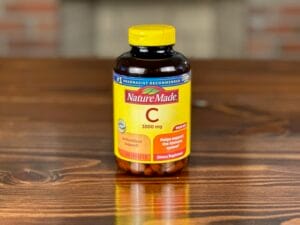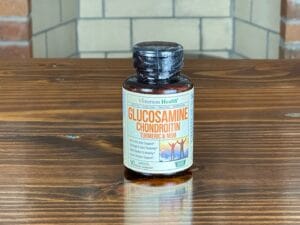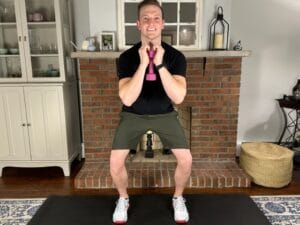Quick Guide: 8 Best Exercises for Osgood Schlatter Disease
The best exercises for Osgood-Schlatter Disease are the prone quad stretch, hamstring stretch, straight leg raise, bridge with band, short arc quad, long arc quad, sidesteps with band, and step downs. These exercises should be completed daily and should not increase your pain or symptoms. This program was created by a Doctor of Physical Therapy who is an Orthopedic Clinical Specialist, make sure to speak to your healthcare provider before initiating a new exercise routine.
1. Prone Quadricep Stretch

- Stretches the quad muscle on the front of your thigh
- Improves flexibility in the muscles on the front of your thigh and knee
- Loop a strap around your foot and pull your heel toward your butt
- Hold this stretch for 10 seconds and repeat 10 times
- Best Stretching Strap in the link below
2. Hamstring Stretch
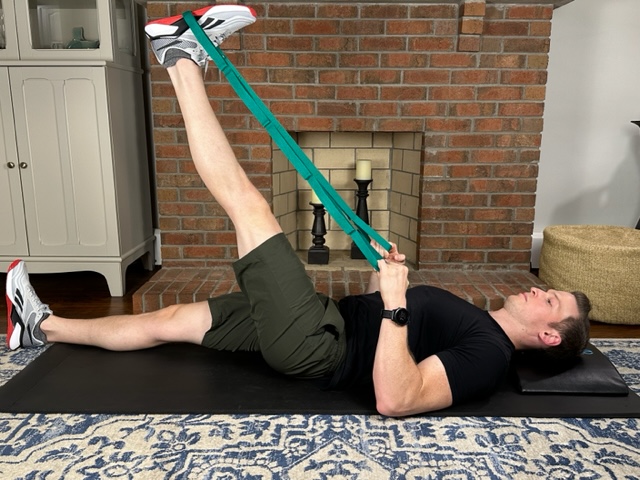
- Stretches the hamstring muscle on the back of your thigh
- Improves flexibility in the muscles behind your knee
- Keep your leg straight and lift off the table with a strap
- Hold this stretch for 20 seconds and repeat 5 times
- Best Stretching Strap in the link below
3. Straight Leg Raise

- Strengthens the quad muscle on the front of your thigh
- Reduces pain in knee by strengthening the quadricep
- Keep your leg straight and lift off the table to the height of your other knee
- Complete 10 repetitions and perform 2 sets
4. Bridge with Band

- Strengthens the glutes and hip muscles
- Reduces forces in the knee by strengthening the hips
- Loop a resistance band around your knees and lift your hips off the table
- Hold the top position for 3 seconds and repeat 20 times
- Best Resistance Band in the link below
5. Short Arc Quad

- Strengthens the quad muscle on the front of your thigh
- Reduces pain in knee by strengthening the quadricep
- Keep your knee on the foam roll and kick your heel off the table
- Complete 20 repetitions and perform 2 sets
- Best Foam Roll and Ankle Weights in the links below
6. Long Arc Quad

- Strengthens the quad muscle on the front of your thigh
- Reduces knee pain by strengthening the quadricep
- Keep your thigh on the table and kick your foot out until your knee is straight
- Complete 20 repetitions and perform 2 sets
- Best Ankle Weights in the link below
7. Sidesteps with Band

- Strengthens the hip and glute muscles
- Reduces forces in the knee by strengthening the hips
- Loop a resistance band around your knees and sidestep
- Complete 20 repetitions and perform 3 sets
- Best Resistance Bands in the link below
8. Step Downs

- Strengthens the quad, hip, and glute muscles
- Improves quadricep muscle and patellar tendon strength
- On a small step, slowly lower your opposite heel to the ground and then stand back up
- Complete 10 repetitions and perform 2 sets
- Best Mini Stepper in the link below
Bonus: Helpful equipment for completing your Osgood-Schlatter exercises.
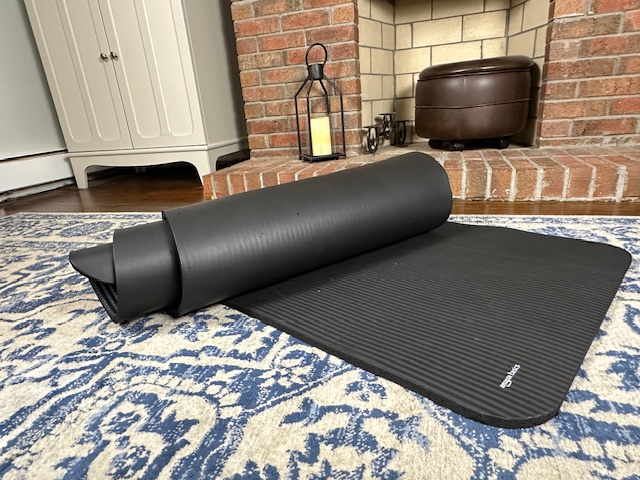
- Thick Yoga Mat provides a soft surface to complete exercises on
- It is lightweight and can be rolled up for easy storage
- You can use it for other stretching and exercise routines as well
- Best Thick Yoga Mat in the link below
Bonus: Helpful equipment for completing your Osgood-Schlatter exercises.

- A Counterforce Brace distributes forces around the knee
- It is beneficial for reducing knee pain related to Osgood-Schlatter
- Commonly used during sports involving running and jumping
- Best Counterforce Brace in the link below
Disclaimers and Disclosures: All information in this article is for informational and educational purposes only and should not be taken as individual medical advice. Additionally, this article contains affiliate links, meaning when you make a purchase, we make a small commission at no additional cost to you. For more information, see our full Disclaimers and Disclosures.
Are you looking for the best exercises to do for your Osgood-Schlatter Disease knee pain?
If you or your child have been dealing with knee pain and diagnosed with Osgood-Schlatter Disease and are looking for the best exercises to help, then you’re in the right place! This aggravating and painful bump on the front of your knee may be leading to distress, but we have the solution for you. A proper physical therapy exercise and stretching routine performed on a daily basis is the most beneficial treatment for Osgood-Schlatters.
As a physical therapist with over 10 years of experience, I have seen many patients with Osgood-Schlatter related knee pain. Because of this, I have created an exercise program specifically designed to address the deficits that are present with this disorder. I have included the most important exercises for Osgood-Schlatter to help you heal and recover faster.
In this article, I will give you an in-depth description of all the exercises you need to be doing for Osgood-Schlatters and how to perform them. Additionally, I will provide recommendations for the best equipment that we use in the clinic with all of our patients to help complete each of these exercises.
If you’re looking to get started right away, then check out our quick guide to the best exercises for Osgood-Schlatter directly above, and then scroll later in the article for the in-depth descriptions of how to perform them.
In-Depth Descriptions: What are the best at home physical therapy exercises for Osgood-Schlatters knee pain?
The best physical therapy exercises for Osgood-Schlatter are the prone quad stretch, hamstring stretch, straight leg raise, bridge with band, short arc quad, long arc quad, sidesteps with band, and step downs. These exercises should be completed one time per day for 2-3 months, or until your knee pain is relieved.
1. Prone Quad Stretch

How to perform the prone quad stretch with a strap exercise for Osgood-Schlatter.
Start by lying on your stomach and loop the strap around your foot. Gently pull on the strap and bend your knee until you feel a stretch on the front of your thigh and knee. Once you feel the stretch, hold it there for 10 seconds and then relax your leg back to the start position. Perform 10 repetitions.
Professional Tip: “If you need an even better stretch, roll up a thick towel or pillow and place it under your knee and then perform the stretch as described above. You should feel an even stronger stretch on the front of your thigh when you do it like this”.
What is the best equipment for the prone quad stretch exercise?
The Stretch Out Strap is the best option for several reasons. It is 6 feet long and has multiple loops and handles all along its length, so it is good for people of different sizes and allows you to get the most comfortable grip. It is also very durable and we have had thousands of patients use it in our clinic and most of them end up buying one for their own use at home. The Stretch Out Strap can be found in the link below.
It’s also nice to have a firm but soft surface to perform this stretch on. A thick yoga mat is an easy solution to this problem and I use one for my stretches at home. You can easily roll it up and store it in a corner or even throw it in your trunk for when you are traveling. The Yoga Mat can be found in the link below.
2. Hamstring Stretch

How to perform the hamstring stretch with a strap exercise for Osgood-Schlatter.
Start by lying on your back with both legs straight and the strap around the middle of your foot. Keep your knee straight and use the strap to pull your leg straight up until you feel a stretch in the back of your leg. Once you feel the stretch, hold it for 20 seconds and then lower back down to the start position. Rest for a second or two and repeat this 5 times.
Professional tip: “Having a slight bend in your knee is ok to start out. But as your body gets used to this stretch, you should work to keep your knee as straight as possible”.
What is the best equipment for the hamstring stretch with a strap exercise?
The Stretch Out Strap is also the best option for this stretch as well. It has great utility and can be used for over 20 different stretches that we commonly have patients perform. There is also a version of this strap that is about a foot longer, the Stretch Out Strap XL, and it works well for people taller than 5’10’’. The Stretch Out Strap XL can be found in the link below.
3. Straight Leg Raise

How to perform the straight leg raise exercise for Osgood-Schlatter.
Start lying on your back with your involved leg straight and your uninvolved leg bent to a 90-degree angle. Tighten the muscle on the front of your thigh, keep your leg straight, and lift it off the table until it is parallel to your other thigh. Pause for a second and then return to the starting position. Repeat this 10 times, take a 30 second break, and perform 2 sets.
Professional tips: “Most of my patients will lift their leg a little too high to start. If you go too far though, you will actually lose tension in the muscle which makes the exercise less effective. Lift your leg just until your knees are the same height and that will do the trick”.
4. Bridge with Band

How to perform the bridge with band exercise for Osgood-Schlatter.
Begin lying on your back with both knees bent and feet planted on the table or floor. Lift your hips toward the ceiling and squeeze your bum at the top position. Hold this position for 3 seconds and then lower back down to the start. Perform 20 repetitions.
Once you have become accustomed to this exercise after about a week, you can add a resistance band to increase the difficulty. Place the band around your knees and as you lift your hips off the table, gently push your knees apart to create a bit of tension on the band.
Professional tip: “It is normal to feel this exercise in your back, butt, hamstrings, and even quads. However, we want the primary mover to be your buttock, so make sure to ‘squeeze your cheeks’ in that top position”.
What is the best equipment for performing the bridge with band exercise.
A loop resistance band is the easiest way to increase the effectiveness of this exercise. You can simply slide the band over your feet and move it up to position it just above your knees. The band increases the amount of muscle recruitment, which will make your hips and butt stronger. The Loop Resistance Bands can be found in the link below.
5. Short Arc Quad

How to perform the short arc quad exercise for Osgood-Schlatter.
Start lying on your back with a bolster under your knee. Slowly, kick your heel off the table until your leg is straight but make sure the back of your knee stays in contact with the bolster. Try to tighten your quad muscle at the top position and then return to the start. Repeat this 20 times, take a 30 second break, and perform 2 sets.
Professional tips: “The first time you do this exercise try it without any weight. If it is easy and relatively pain-free then you can try adding a pound to the ankle weight. Slowly keep adding weight over the days and weeks, but it’s better to go a little slower rather than overdoing it”.
What is the best equipment for the short arc quad exercise?
It is important for the ankle weights to fit comfortably and securely around your ankle. Another really nice feature is the ability to adjust the amount of weight that it holds. These ankle weights meet all of these criteria, are highly rated, and are sold in pairs which can give you even more weight to use if you’re feeling extra strong! The Ankle Weights can be found in the link below.
The bolster that your knee is supported on should be firm but comfortable. A diameter of about 6 inches works best, so a foam roller is my favorite piece of equipment for this exercise. It’s also really nice because you can use it for other mobility work you may do such as rolling out your quads, IT band, and hamstrings. I love getting pieces of equipment that can serve a bunch of different purposes and be used over and over again. The Foam Roll can be found in the link below.
6. Long Arc Quad

How to perform the long arc quad exercise for Osgood-Schlatter.
Start sitting in a chair or on the side of your bed with your knees bent. Slowly kick your foot all the way out until your leg is straight and the back of your thigh is still on the surface. Try to tighten your quad at the top position for a second and then return to the start position. Repeat this 20 times, take a 30 second break, and perform 2 sets.
Professional tips: “Begin by using a one-pound weight the first time you perform the long arc quads. If the exercise is easy and relatively pain-free then you can add a pound to the ankle weight every few days. Slowly keep progressing to build the strength in your quadriceps”.
What is the best equipment for the long arc quad exercise?
You can use the same ankle weights that you used for the short arc quad exercise above. Since these ankle weights are adjustable, you can quickly switch the weight if you need more or less for this exercise. However, most of the time, I will have my patients use the same amount of weight for both of these exercises. The Ankle Weights can be found in the link below.
7. Sidesteps with Band

How to perform the sidesteps with a band exercise for Osgood-Schlatter.
Start by standing with a resistance band looped around your thighs, just above your knees. Bend your knees slightly so you are in a mini squat position and press your knees apart, so you are always keeping tension on the band. Make sure to keep your toes pointed forward and slowly step sideways, always keeping a space between your feet.
Take 20 steps in one direction, stay facing the same way, and then take 20 steps back to the start position. Take a 15 second break and repeat 3 times.
Professional Tip: “This exercise is designed to make you feel a bit of a burn in your hips, thighs, and buttock. Start with a light resistance band and once you can get through all 3 sets with relative ease, it’s time to increase the tension of the resistance band”.
What is the best equipment for performing the sidesteps with a band exercise?
The best equipment for the sidesteps with a band exercise is a set of loop resistance bands that are easy to put on and take off. These are the same bands that you used for the bridging exercise listed earlier. You will want a set of these bands so you can start with low resistance and slowly increase the tension of the band as you get stronger. The Loop Resistance Bands can be found in the link below.
8. Step Downs

How to perform the step-down exercise for Osgood-Schlatter.
Start by placing a small step next to your counter or other stable surface. Hold on to the counter and stand on the stepper with your affected leg. Slowly bend your knee and lower the opposite heel to the ground. The cue I like to tell my patients for that heel is, “pretend there is a potato chip on the ground that you want to touch with your heel, but not crack”. Then stand back up to the start position. Repeat 10 times, take a 30 second break, and complete 2 sets.
Professional tips: “Start with a 4-inch step height when you begin this exercise. Once you can perform all the repetitions without pain and with relative ease, increase the step height by 2 inches. A normal height step is 8 inches, so I have my patients work toward this goal”.
“This exercise is a lot more difficult than it looks, especially on a bum knee. It is also typically a little bit uncomfortable to do when you have Osgood-Schlatter knee pain. So, I recommend trying to keep your pain levels below a 2-3/10 when you are doing this exercise and progressing slowly”.
What is the best stepper for performing the step-down exercise?
For the step-down exercise, you will want a stepper that is adjustable and that has good traction. The stepper below is nonslip and allows for variable heights so you can progress as your symptoms permit. This stepper is great because of its versality and the number of exercises you can do on it. We have hundreds of patients do dozens of different exercises on them, so they come in pretty handy. The Stepper can be found in the link below.
Best Exercises for Osgood-Schlatter Disease Knee Pain Final Thoughts
I know there is no part of Osgood-Schlatter that is fun to deal with. I have treated many patients with this disorder and the good news is that all of them eventually get better. The stretches and exercises listed above are the best ones at alleviating your symptoms and getting you on to the path to recovery.
Some people are able to do these exercises for a few weeks and feel better, while others need to keep at it for a few months. Also, it’s not uncommon for your pain to return during times of a growth spurt. Because of this, I recommend that my patients continue these exercises a few times a week once their symptoms have resolved. I wish you a speedy recovery and good luck on your journey to pain-free knees!
Why trust Physical Therapy Simplified for exercises for Osgood-Schlatter?
At Physical Therapy Simplified, our mission is to provide an easily accessible and highly reputable source of physical therapy information that anyone can understand, follow, and benefit from. We want you to feel confident that you are getting the best content and information that will help to reduce your pain and restore you to your highest functional potential.
The author of this article, Andrew Harkins, DPT, has demonstrated expertise in the field of physical therapy and is certified by the American Board of Physical Therapy Specialities as an Orthopedic Clinical Specialist. He has over ten years experience as a licensed physical therapist and is an expert in treating conditions related to the knee.
Andrew has worked as a teaching assistant at the University of Pittsburgh in their Doctor of Physical Therapy Program. Specifically, due to his expertise in treating knee conditions, he assisted in musculoskeletal coursework and provided instruction on how to treat patients with knee pain.
